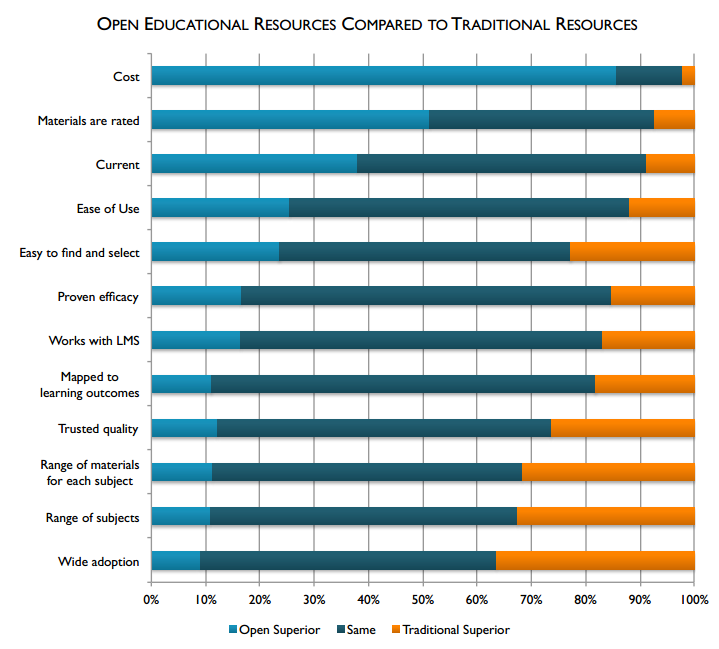You have /5 articles left.
Sign up for a free account or log in.
When faculty members choose which textbooks to assign to their students, they look for trusted names and a track record of quality -- not the price tag, a new survey suggests.
While those priorities may stymie the growth and adoption of open educational resources (OER), the Babson Survey Research Group’s report on faculty members’ attitudes and opinions about those resources contains both “terrible” and “incredible” news for proponents of OER, depending on your interpretation. On one hand, faculty see open resources as just as good -- if not better -- than the products produced by traditional publishers. On the other, few faculty members have actually heard about OER.
David Wiley, founder of the OER support provider Lumen Learning, said the disappointing top-level numbers overshadows the fact that many faculty members are satisfied with the quality of open content.
“I look at this and I think, holy smokes, this is just some of the best possible news we could have gotten,” Wiley said in an interview. “The ‘problems’ with OER adoption are so eminently solvable.”
The OER movement has sprung up in response to the rising cost of higher education, and aims to curb one of the additional fees that sometimes take students by surprise once they make it to campus -- namely textbook prices. A study published this January, for example, found nearly half of surveyed students chose their courses based on textbook prices, and some simply avoided courses with expensive course materials.
Yet textbook costs hardly register among faculty members. Only 2.7 percent of the surveyed faculty named it the most important criterion for selecting teaching resources, coming in behind such factors as wide adoption, faculty ratings and learning management system support.
Many students have fled to the less-expensive used and rental book markets in search of savings, but proponents of OER have another plan to cut costs: Produce high-quality course content, then make that content available publicly or under a license that permits widespread use.
Despite their cost-cutting potential, OER still have an awareness problem, according to the survey. Nearly two-thirds of the surveyed faculty members, or 65.9 percent, said they had either never heard of OER, or had heard some but didn’t know much about them. Only 5.1 percent of the faculty members said they were very aware of OER.
“Taken together, this is terrible news, if not unsurprising news, for OER advocates,” Phil Hill, a higher education consultant, wrote in a blog post. “It should be no wonder that it is so difficult to reduce the financial burden of textbook purchases by students. By and large, the people making the resource decisions are not aware of OER [and] free options, and the cost of material is a very low priority.”
More than half of the instructors said they were deterred by the lack of search tools or a comprehensive catalog of open resources. Those deterrents added up to a slight drop in discoverability. About one-third of faculty members, or 33.1 percent, said searching for open content was very difficult, compared to 25.1 percent who said the same about traditional content (still, a majority of instructors described discovering either type of content as very easy).
In a point-by-point comparison with traditional content, however, OER fared better. Traditional content offers a wider range of subjects and enjoys higher adoption, faculty members aware of OER said, but open content is easier to use, more likely to be up to date and -- as expected -- less expensive. OER even edged out traditional content on which is the most effective, 16.5 percent versus 15.3 percent, respectively.
Most crucially to OER proponents, faculty didn’t see a huge quality gap between traditional and open resources. More than half, or 57.2 percent, said the two types of course content offer the same level of quality, compared to 26.6 percent who said OER is inferior.
In a separate blog post, Wiley described those numbers “incredible.”
“As you see in the survey data, there are essentially no barriers to entry to OER -- no preconceptions or misconceptions on the part of faculty,” Wiley said. “As soon as they hear about it and understand it, they like it.”
In other words, OER providers don’t have to fight an uphill battle to convince faculty members that open resources can be just as good as the textbooks -- just that the alternatives exist. “It’s relatively straightforward to make people aware of things,” Wiley added.
Pearson, which supported the survey along with the William and Flora Hewlett Foundation, in a statement stressed the importance of efficacy -- a word that has become something of a corporate mantra. “With increasing demand for effective course content that keeps students engaged and improves learner outcomes, it’s anticipated that more educators will require proven OER material that demonstrates measurable results,” John Tweeddale, the company’s senior vice president of efficacy and quality, said.
Richard Baraniuk, founder of the open textbook publisher OpenStax College, suggested some faculty members may be using OER without them being aware of it. The company’s own textbooks are now used by more than 300,000 students in nearly 1,100 courses, he said.
“OpenStax College’s results are consistent with the finding that faculty are supportive of the concepts and goals of OER, even if they aren’t familiar with the acronym,” Baraniuk said in an email. “Open makes us more competitive, and is central to our mission; however, at the end of the day we compete on quality, student outcomes and overall value, just like everyone else in the market.”





